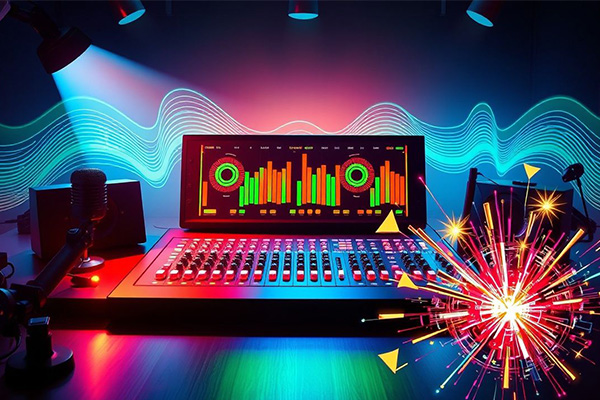Want to take your productions to the next level? Here are 3 Tips to Make Your Tracks Stand Out that will surprise and excite your listeners. Whether you’re a seasoned producer or just starting out, these techniques can elevate your music and captivate your audience like never before. Let’s dive into the details of each tip and explore how they can transform your tracks into unforgettable experiences.
In the realm of music production, standing out is essential for capturing attention and creating a lasting impact. The following sections will delve deeper into each of the three tips, illustrating their importance with practical examples, insights from industry professionals, and ways to implement them effectively in your own productions.
Creative drop-outs are not just a tool; they are a form of storytelling in your music. For instance, a track that successfully utilizes drop-outs may create a moment of suspense before the chorus, making the drop more impactful. Some iconic tracks have mastered this technique, leading to unforgettable listening experiences.
Imagine a song that builds up to a powerful drop. The drop-out can occur just before that moment, stripping away the instrumental layers to leave only the vocals. This technique not only emphasizes the lyrics but also creates a heightened sense of anticipation. A well-known example of this can be found in many pop and electronic hits where the silence before the drop amplifies the energy of the following beat.
1. Creative Drop-Outs
Consider the impact of spotlighting the vocal in a dance track. By isolating the singer’s voice, you allow the message of the lyrics to resonate with the audience. This tactic can be particularly effective during a heartfelt bridge or a powerful hook.
Building anticipation through drop-outs can transform the energy of a song. When a pre-chorus suddenly removes the rhythmic elements, listeners may feel a sense of loss that is rectified by the exhilarating return of the full instrumentation in the chorus.
Dynamic contrast is crucial in music. When sections are stripped down, it invites listeners to engage with the remaining elements. For instance, a minimalistic approach can lead to a more powerful experience when the full soundscape returns.
In addition to drop-outs, smart filtering can significantly enhance your track’s emotional journey. Each filter sweeps can evoke different feelings, guiding your audience through the highs and lows of the song’s narrative.
For example, using a low-pass filter during an introspective verse can create a sense of confinement. When the chorus bursts open with full-frequency brightness, it feels like a release, making the experience more profound.
Strategic drop-outs can add power and surprise to your music. Knowing when to remove sound is key. Think about the emotional journey you want your listeners to experience. Effective drop-outs create a dynamic contrast that not only adds excitement but also allows elements of your track to breathe. Consider these various scenarios:
High-pass filtering can be particularly effective in genres like house or techno, where the emphasis on rhythm and energy is crucial. Gradually removing the bass can build suspense, making the eventual drop all the more electrifying.
- Spotlight the Vocal: Drop all instruments for a lyric or phrase. This makes the words stand out and creates a memorable moment.
- Build Anticipation: Remove the bass or drums in the pre-chorus. Bring them back in the chorus for maximum impact.
- Dynamic Contrast: Strip down busy sections to just one or two elements. This keeps your track fresh and engaging.
Automated transitions using filters can create a flow that keeps the listeners engaged. By carefully crafting these movements, you can deliver a track that feels alive, with constant evolution.
Fills serve as the connective tissue between sections of your track, and using unique sounds can make these transitions memorable. Instead of relying solely on typical drum fills, consider introducing unexpected elements that add character.
For instance, incorporating unconventional samples can create a sense of intrigue. Imagine hearing a sudden burst of a retro video game sound effect right before a drop—a clever way to engage listeners and make them smile.
2. Smart Filtering for Contrast
DIY sound design opens a world of possibilities. By recording everyday sounds and manipulating them, you can create a signature style that sets your music apart. It’s an excellent way to express your creativity and make your tracks feel personal.
Rhythmic complexity can also play a significant role in how engaging your fills are. When layering percussion, think about how different rhythms interact. Polyrhythms can add a rich texture that keeps listeners on their toes.
Filtering can guide emotions and create energy shifts. Use it to shape your track’s flow. Thoughtful filtering can be the difference between a good track and a great one. When you control the frequency content, you’re controlling the listener’s perception of energy and space.
Push your creative boundaries by experimenting with these techniques. The music production landscape is ever-evolving, and innovation is key to standing out. Challenge yourself to break away from the norm, and your audience will appreciate the unique sound you’ve cultivated.
- Low-Pass Teasing: Roll off high frequencies during the pre-chorus. Open the filter in the chorus to flood the mix with brightness.
- High-Pass Energy Control: Gradually remove the bass during a verse. Bring it back for a powerful drop or chorus.
- Automated Transitions: Use automation to sweep filters in and out. Create tension and resolution with movement.
3. Unforgettable Fills with Unique Sounds
Fills are perfect for adding personality to your track. Turn standard transitions into standout moments. Unique fills can set your track apart and keep listeners on their toes. Consider using unexpected sounds to create fills that are not only effective but also memorable.
- Unconventional Samples: Use unique sounds like construction tools, animal calls, or retro game effects. These will grab attention.
- DIY Sound Design: Record your own samples—pots banging, doors creaking, or even your voice with effects. Make them your signature.
- Rhythmic Complexity: Layer percussion or play with polyrhythms. Creative timing and sound design will keep your fills exciting.
Experiment with these ideas and push your boundaries. Break the rules and find what works for your sound. Your listeners will thank you! Remember, creativity knows no bounds, and the more you explore, the more unique your sound will become. Embrace the process, and let your artistic vision shine through every track you create.



